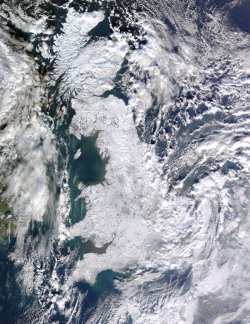By Hamish Johnston
As someone who spent a few years on the Canadian prairies, where the mercury regularly dips to –40 °C, I should be the last one to describe Britain’s winters as cold and dry. Indeed, just a few years ago I was mowing the lawn in January to ensure that the grass wasn’t a rotting mess come spring.

But then in 2009 something changed. The winters here in Bristol seemed to go from being warm and wet to being cold and dry. The NASA satellite image on the right shows the entire island of Great Britain blanketed in snow in January 2010 – something that very rarely happens.
The last few winters were so dry that a drought was declared in much of southern and central England this spring (and then it started raining and hasn’t stopped).
It would be nice to be able to predict what the next British winter will be like – but seasonal forecasts are notoriously difficult to make. The UK’s Met Office used to go public with its predictions, but stopped in 2009 when its promise of a “barbeque summer” turned into a washout.
Now, scientists at the Met Office are saying that their latest forecasting system should be able to forewarn of a cold winter. They say that such cold snaps can be caused by the disruption of the “polar vortex” – a large-scale cyclone that blows in the middle and upper troposphere and in the stratosphere above the polar regions during the winter. In the northern hemisphere, the vortex drives the westerly winds that bring warm, damp air to Britain in the winter.
Such vortex disruptions seem to occur when warm air piles into the stratosphere. In order to predict such events better, the Met Office has begun using a so-called high-top version of its GloSea4 seasonal-forecasting model. This version calculates physical quantities such as winds, humidity and temperature to higher levels in the atmosphere and also at more levels.
You can read a news article about the new system on our sister website environmentalresearchweb and a paper is available in the journal Environmental Research Letters.



